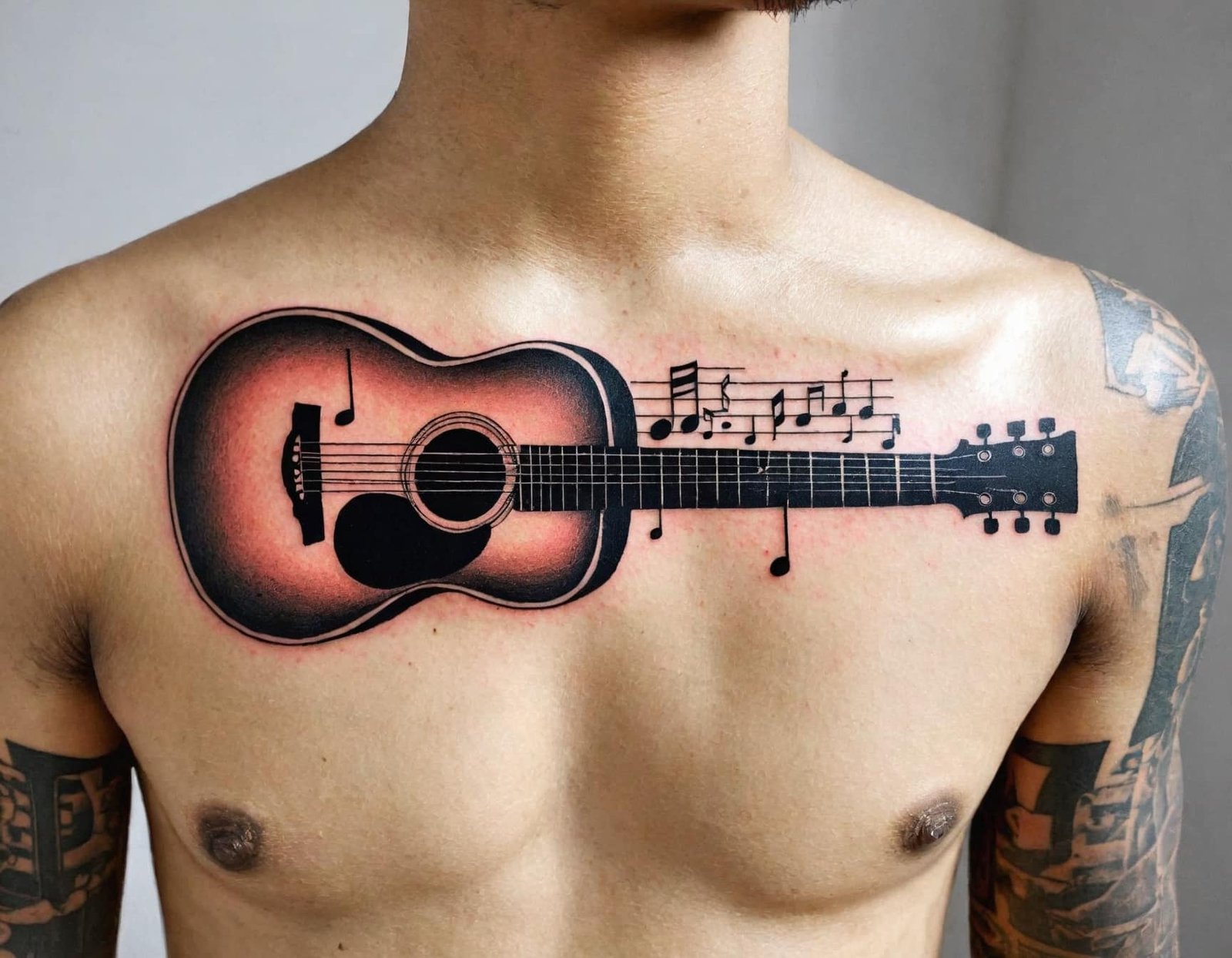Music has this uncanny ability to pierce straight through our defenses and nestle itself deep in our souls. It’s no wonder that so many people choose to wear their musical passions permanently on their skin. Getting a music tattoo isn’t just about decoration—it’s about carrying a piece of your soundtrack with you wherever life takes you.
Whether you’re a weekend warrior who belts out karaoke classics or a classically trained musician who bleeds quarter notes, there’s a tattoo design that speaks to your musical heart. The beauty of music tattoos lies in their incredible versatility and the personal stories they tell.
1. Sound Wave Tattoos That Capture Your Favorite Moment
Sound wave tattoos have exploded in popularity, and for good reason. These designs transform audio into visual art, creating a unique fingerprint of your most cherished musical moments. You could immortalize your wedding song, your child’s first laugh, or that guitar solo that gave you goosebumps.
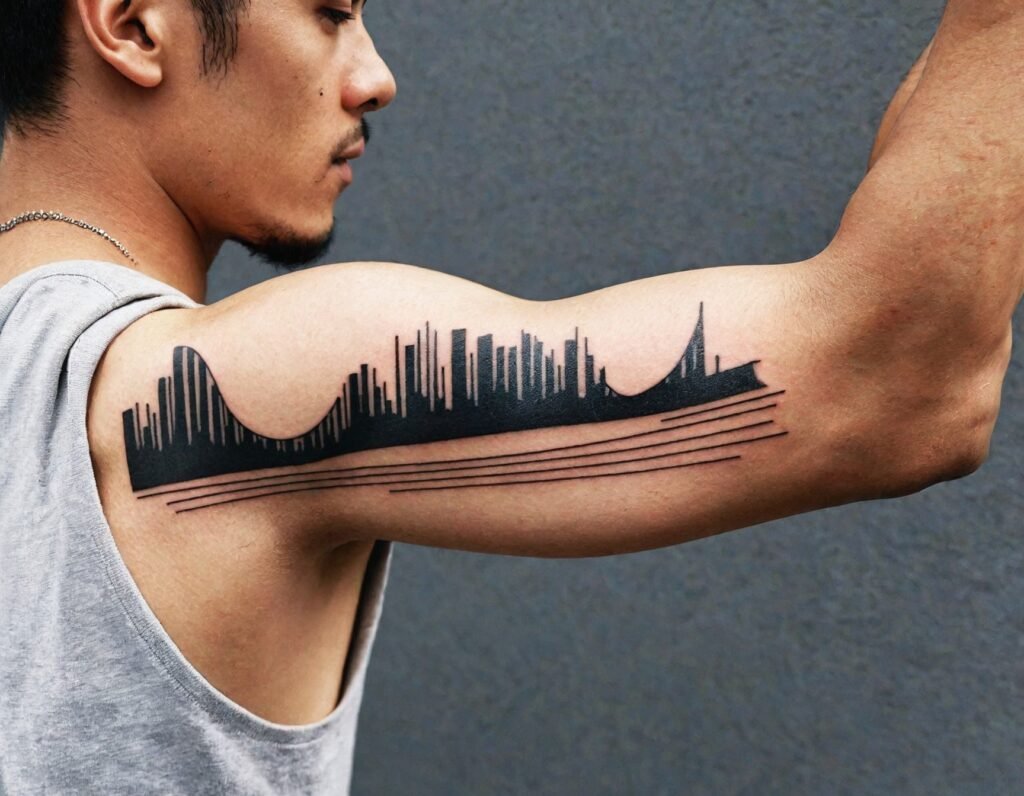
The process is surprisingly straightforward—you upload an audio file to specialized software that converts it into a visual waveform. Most tattoo artists can work with these digital files to create stunning linear designs that wrap around arms, trace along collar bones, or flow down the spine.
What makes these tattoos particularly special is their hidden nature. To the casual observer, it might just look like an abstract geometric pattern. But you’ll always know it represents that moment when your favorite singer hit that impossible high note, or when your grandmother hummed that lullaby. The intimacy of these designs makes them incredibly meaningful.
Some people choose to add small details like musical notes floating above the waves or incorporate the song title in delicate script. Others prefer the clean minimalism of just the wave itself. There’s no wrong approach here—it’s all about what resonates with your personal aesthetic.
2. Lyric Tattoos in Beautiful Typography
Words have power, and when they’re set to music, they become downright magical. Lyric tattoos allow you to carry inspirational, meaningful, or simply beautiful words with you always. The key to a stunning lyric tattoo lies in choosing the right typography and placement.
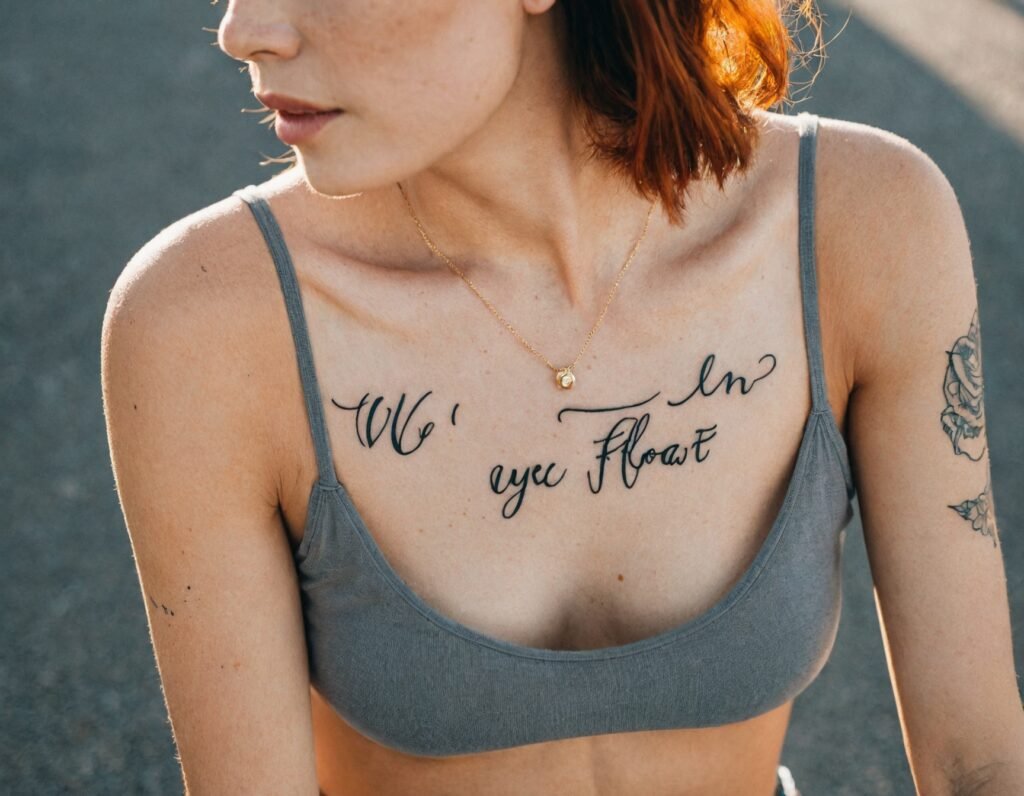
Script fonts work beautifully for romantic ballads or introspective indie lyrics. They flow naturally along the curve of a shoulder or the inside of a forearm. For punk rock anthems or rap verses, bold sans-serif fonts pack more visual punch. Sometimes the contrast between delicate handwriting and powerful lyrics creates an intriguing juxtaposition.
Consider the language of your chosen lyrics too. Foreign language lyrics can be particularly striking—imagine a line from a French chanson flowing across your ribs, or Japanese characters from your favorite J-pop song adorning your ankle. The visual beauty of different alphabets adds another layer of artistry.
Placement is crucial for lyric tattoos. Longer quotes work well on the torso, back, or thigh where there’s ample space. Shorter phrases shine on wrists, behind ears, or along the collarbone. Think about how the text will flow with your body’s natural lines. A skilled tattoo artist can help you visualize how the words will look when you move and gesture naturally.
3. Vintage Record Player Designs
There’s something irresistibly nostalgic about vinyl records and the turntables that spin them. These tattoos tap into our collective memory of a time when music was a more tactile experience. You had to carefully handle records, drop the needle just right, and sit through entire albums instead of shuffling through playlists.
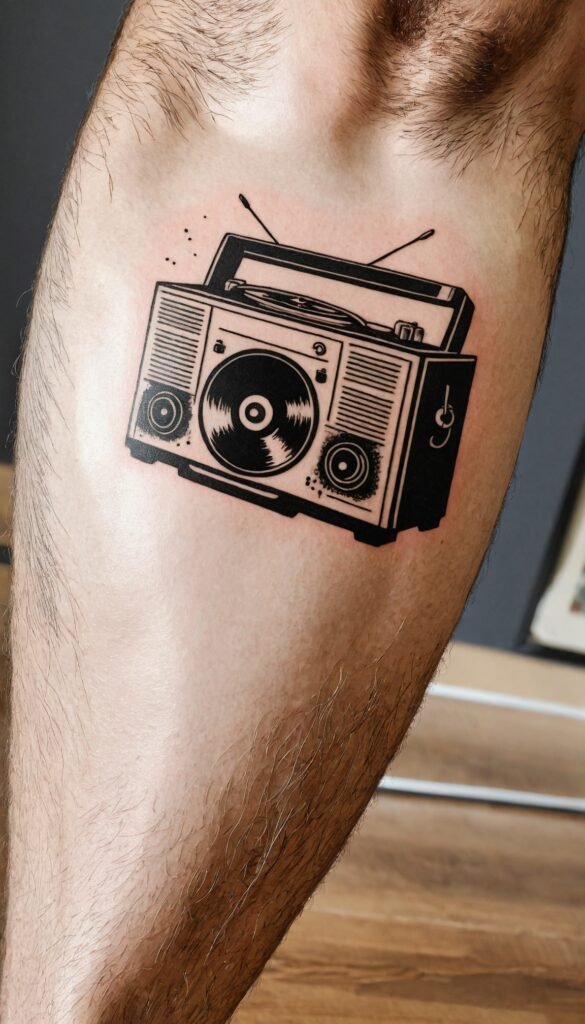
Vintage record player tattoos can range from highly detailed realistic reproductions to stylized cartoon versions. Some people opt for the classic Technics 1200 turntable that dominated DJ booths for decades. Others prefer the elegant curves of a 1950s console record player with its warm wood grain and chrome accents.
The beauty of these designs lies in their ability to represent not just music, but an entire era and attitude. They speak to craftsmanship, to taking time to appreciate art, and to the ritual of music listening. Adding small details like a specific record label or even the grooves of a particular album can make the tattoo even more personal.
Many people choose to surround their record player with musical notes that seem to float up from the spinning disc. Others incorporate flowers or geometric patterns that complement the circular motifs of the records themselves. The possibilities are endless when you start thinking about how to personalize this classic design.
4. Musical Note Compositions
Sometimes the simplest ideas are the most elegant. Musical note tattoos can be surprisingly sophisticated when executed with creativity and skill. Instead of just getting a random treble clef, consider how different notes and symbols can work together to create a meaningful composition.
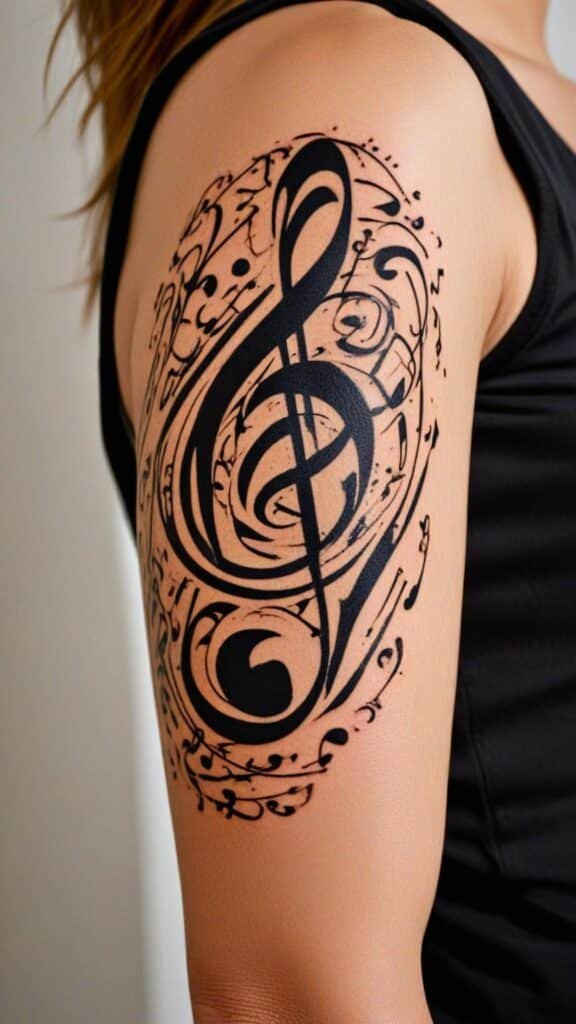
A single musical phrase from your favorite song can be transformed into a flowing design. Maybe it’s the opening notes of Beethoven’s Fifth Symphony marching boldly across your shoulder blade. Or perhaps it’s the delicate melody from a folk song your mother used to sing, curving gently around your wrist.
The placement of these tattoos can be as important as the notes themselves. Notes that climb up your neck suggest ascending scales and growing intensity. A phrase that wraps around your arm creates a sense of movement and continuity. Some people choose to have notes scattered across their body like musical confetti, each one representing a different song or memory.
Don’t forget about the staff lines either. They can add structure to your design or be omitted for a more minimalist approach. Experimenting with different clefs—treble, bass, alto—can also add visual interest and represent different aspects of your musical identity.
5. Instrument Silhouettes and Portraits
Your instrument is more than just a tool—it’s an extension of yourself. Instrument tattoos celebrate this intimate relationship between musician and their chosen voice. These designs can range from simple black silhouettes to incredibly detailed portraits that capture every curve and reflection.
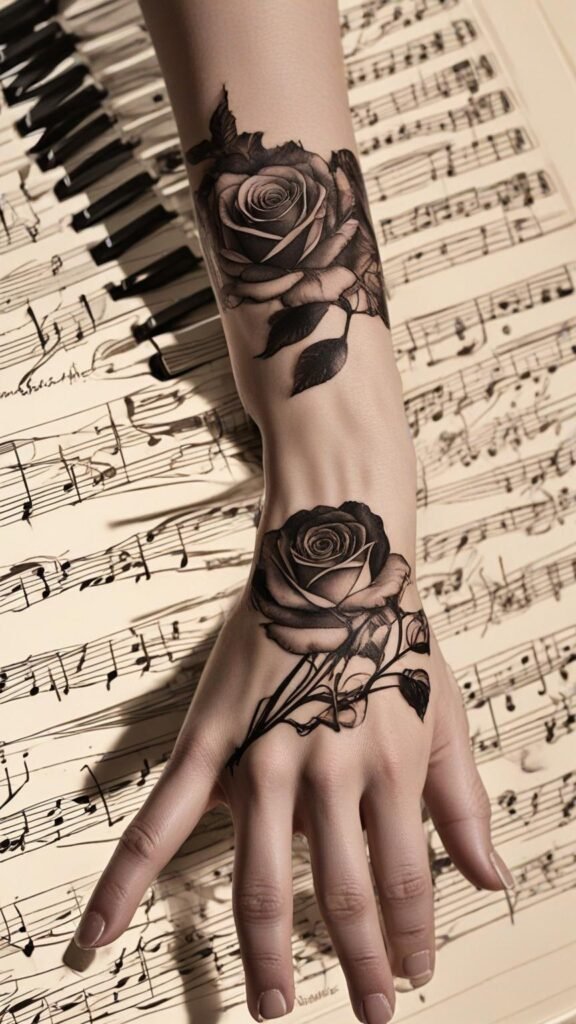
Guitar tattoos are perennially popular, and for good reason. The curves of an acoustic guitar create beautiful lines that work well with the human body’s natural contours. Electric guitars offer more angular possibilities, especially iconic shapes like the Fender Stratocaster or Gibson Les Paul. Bass guitars make for striking larger pieces with their elongated proportions.
But don’t overlook other instruments. A violin’s elegant f-holes create gorgeous negative space in tattoo designs. Drum sets offer opportunities for complex, layered compositions. Even less common instruments like saxophones, accordions, or banjos can make for stunning tattoo art when rendered by a skilled artist.
Consider whether you want a realistic portrait of your actual instrument or a more stylized interpretation. Some people choose to add personal touches like worn spots where their fingers naturally rest, or small dents and scratches that tell the story of countless hours of practice. Others prefer pristine, idealized versions that capture the essence of the instrument without the wear and tear.
The key is working with a tattoo artist who understands the importance of proportion and detail. Instruments have specific shapes that people instinctively recognize, so getting these details right is crucial for a successful tattoo.
6. Music-Themed Mandalas and Geometric Patterns
Mandalas have deep spiritual significance in many cultures, representing the universe, wholeness, and the journey toward enlightenment. When combined with musical elements, they create tattoos that speak to music’s role in our spiritual and emotional lives.
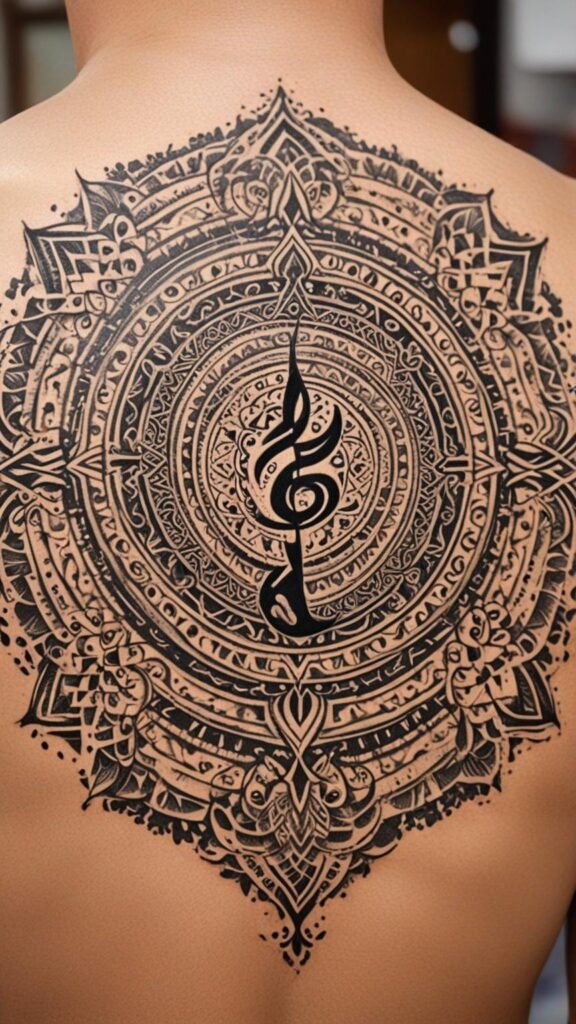
Musical mandalas might feature concentric circles of notes, instruments arranged in symmetrical patterns, or sound waves radiating outward like ripples in a pond. The circular nature of these designs makes them perfect for placement on shoulders, backs, or as striking forearm pieces.
Geometric patterns offer another avenue for incorporating musical themes. Fibonacci spirals—the mathematical sequence that appears throughout nature—can be filled with musical notes to represent the mathematical beauty underlying all music. Sacred geometry combined with musical elements creates tattoos that are both visually striking and intellectually satisfying.
These designs work particularly well for people who see music as a form of meditation or spiritual practice. They can represent the idea that music connects us to something larger than ourselves, whether that’s the universe, nature, or simply the collective human experience.
7. Microphone and Studio Equipment Tributes
For vocalists and audio engineers, microphones and studio equipment hold special significance. These tools are the bridge between artistic vision and recorded reality. Tattoos featuring vintage microphones, mixing boards, or studio monitors celebrate the technical craft behind musical creation.
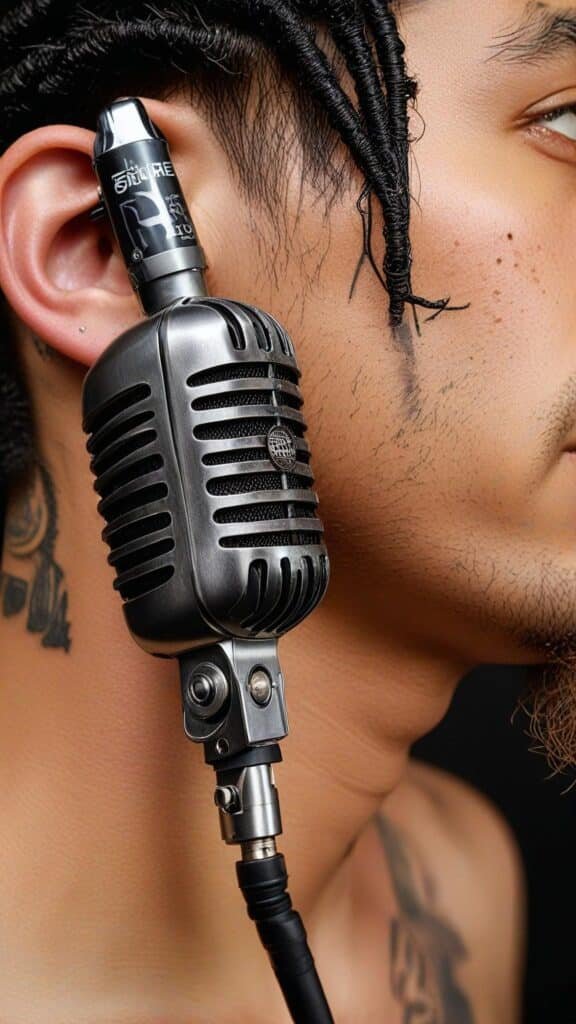
Classic ribbon microphones from the 1940s and 50s have particularly elegant shapes that translate beautifully to tattoo art. Their Art Deco styling and distinctive silhouettes make for timeless designs. Modern condenser microphones offer different aesthetic possibilities with their sleek, technical appearance.
Mixing boards and audio equipment provide opportunities for more complex, detailed tattoos. The rows of faders, knobs, and switches create interesting geometric patterns. Some people choose to have their board settings tattooed exactly as they were during a significant recording session, preserving that moment of creative discovery forever.
These tattoos often work best when combined with other musical elements. Notes flowing out of a microphone, sound waves emanating from speakers, or musical phrases wrapping around equipment create dynamic, story-telling designs that capture the entire creative process.
8. Music Festival and Concert Memorabilia
Live music experiences create some of our most powerful memories. The energy of a crowd, the thrill of hearing your favorite song performed live, the sense of community with thousands of strangers—these moments deserve to be commemorated.
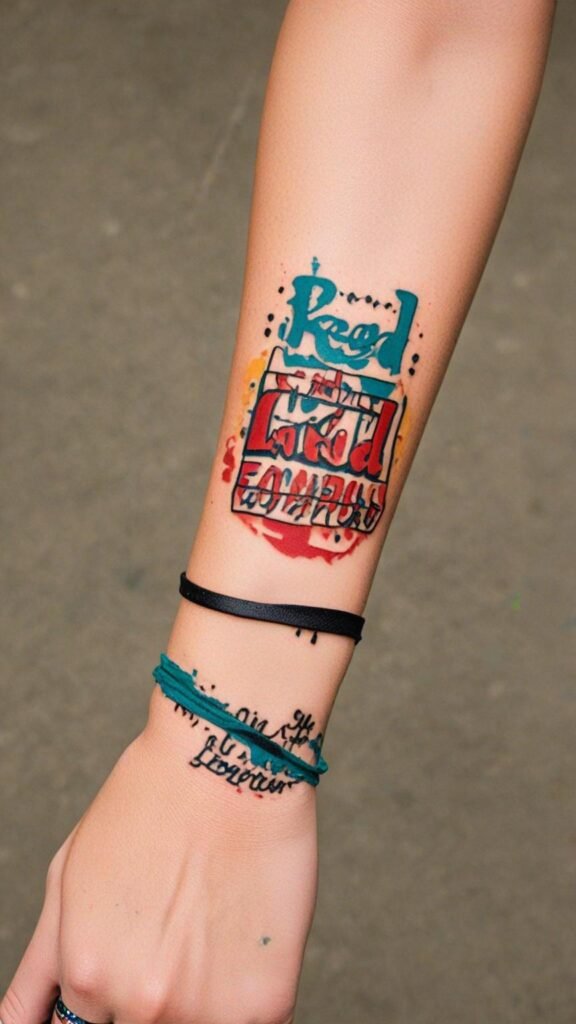
Some people choose to get tattoos representing specific festivals they’ve attended. Woodstock’s iconic dove and guitar, Coachella’s distinctive typography, or Burning Man’s radical self-expression ethos all translate into meaningful tattoo designs. These tattoos become conversation starters and ways to connect with fellow festival-goers.
Concert ticket stubs, backstage passes, and set lists can also inspire tattoo designs. The typography and graphics from these ephemeral items capture a specific moment in time. Some people recreate their ticket stub exactly, complete with the venue name, date, and seat number. Others use elements from multiple concerts to create a collage-style design.
Band logos and album artwork offer another avenue for music memorabilia tattoos. Just make sure you’re choosing something with lasting significance to you—musical tastes can evolve over time, but tattoos are considerably more permanent than your Spotify playlists.
9. Musical Staff and Composition Sheets
For formally trained musicians, sheet music represents the language through which musical ideas are communicated. Tattoos featuring musical staffs, complete compositions, or fragments of handwritten scores create sophisticated designs that celebrate musical literacy.
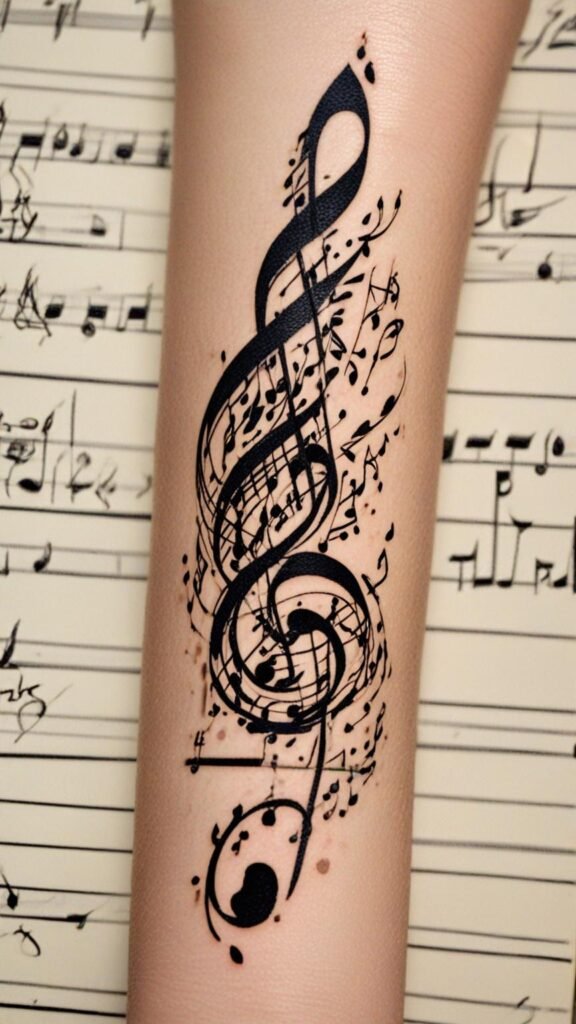
A single measure of music can be surprisingly expressive when rendered as a tattoo. The visual rhythm of notes on a staff creates its own artistic appeal, separate from the music it represents. Some people choose to tattoo their own compositions, making their body a canvas for their creative work.
Handwritten sheet music adds another layer of personality to these designs. Composers’ and musicians’ handwriting has its own character—Mozart’s neat precision, Beethoven’s passionate scrawl, or your own professor’s meticulous annotations. These human touches make the tattoos feel more personal and connected to the act of musical creation.
Consider incorporating other elements like coffee stains, eraser marks, or margin notes that reflect the real experience of working with sheet music. These imperfections tell the story of the creative process and make the tattoo feel more authentic.
10. Music and Nature Fusion Designs
Music and nature have been intertwined since the first human heard rhythm in ocean waves or melody in bird songs. Tattoos that combine musical elements with natural imagery create designs that speak to music’s organic, fundamental place in our world.
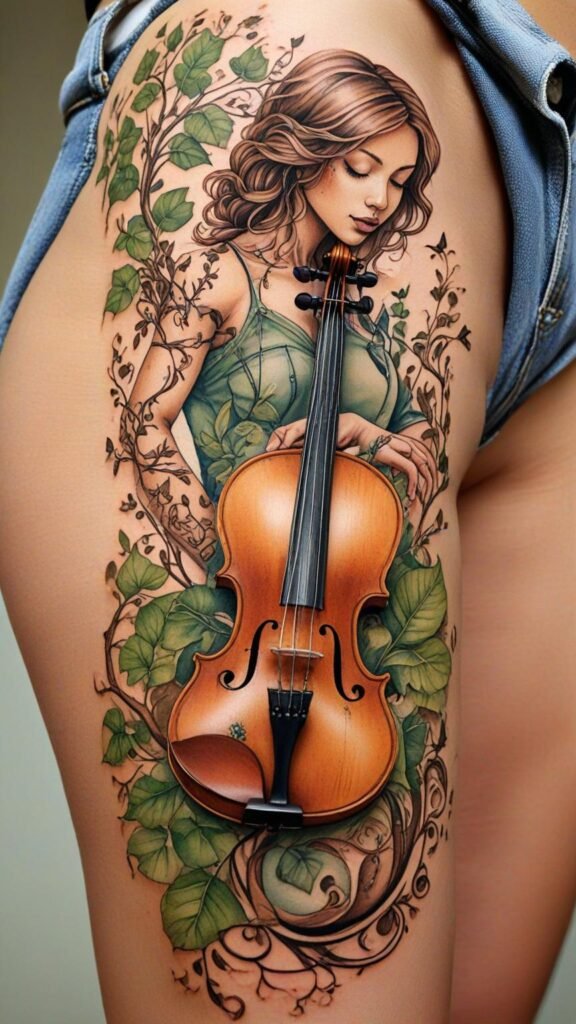
Birds are natural choices for music-nature fusion tattoos. Songbirds with musical notes floating from their beaks create whimsical, joyful designs. Ravens or crows can represent darker, more complex musical emotions. Some people choose to have specific birds that represent particular songs or musical memories.
Trees offer another rich metaphor for musical growth and connection. Musical notes can replace leaves, or staff lines can form branches. The roots of the tree might extend into musical notation, suggesting that music is fundamental to our existence. These designs work particularly well as larger pieces that can incorporate multiple musical elements.
Flowers provide opportunities for more delicate, feminine designs. Musical notes can spiral around rose stems, or petals can be shaped like different musical symbols. Water elements—waves, raindrops, rivers—can be combined with sound waves to create flowing, dynamic designs that capture music’s fluid nature.
The key to successful music-nature fusion tattoos is finding the right balance between the two elements. Neither should dominate completely—instead, they should work together to create something that wouldn’t exist without both components.
Music tattoos are deeply personal expressions of our relationship with sound, rhythm, and melody. They tell stories about pivotal moments, beloved artists, and the role music plays in our daily lives. Whether you choose a simple musical note or a complex composition, your tattoo will be a permanent reminder of music’s power to move, inspire, and connect us.
The most important thing is choosing a design that resonates with your personal musical journey. Work with an experienced tattoo artist who understands the importance of musical details and can help bring your vision to life. After all, just like music itself, the best tattoos are those that speak directly to the soul.
11. Frequency and Equalizer Bar Tattoos
The visual representation of sound through equalizer bars creates some of the most modern and tech-savvy music tattoos available today. These designs capture the digital age of music consumption while maintaining an elegant, minimalist aesthetic that works across various body placements.
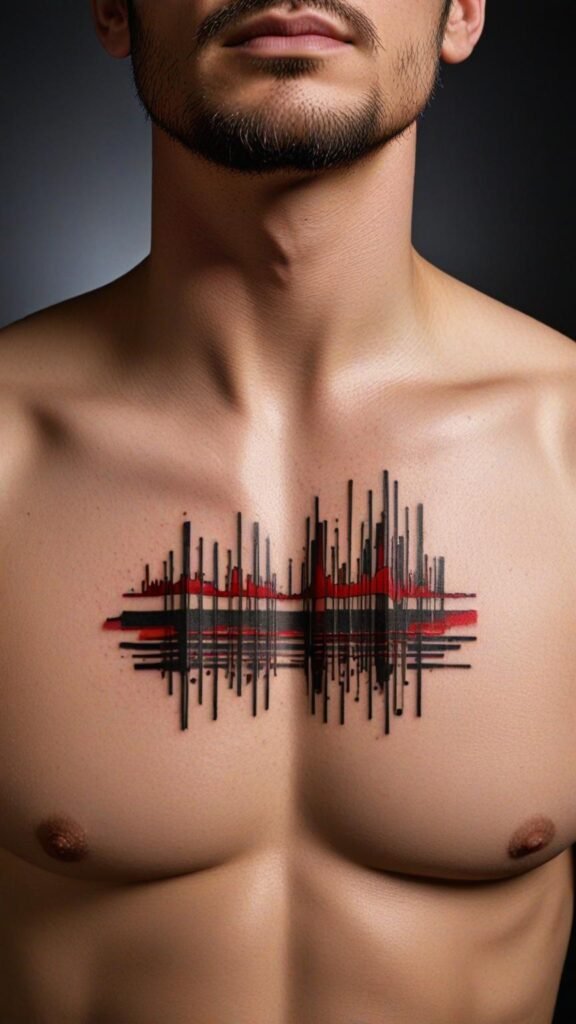
Equalizer bars can be customized to show the exact frequency response of your favorite song during its most powerful moment. Imagine having the EQ signature of that earth-shattering bass drop or soaring vocal climax permanently etched on your forearm. The vertical bars create natural rhythm and movement, making them perfect for wrapping around limbs or following the spine’s natural curve.
Some people choose to incorporate color gradients that shift from deep bass frequencies in rich purples and blues to bright treble frequencies in yellows and whites. Others prefer the stark elegance of solid black bars against skin. The beauty lies in how these seemingly technical representations become deeply personal artistic statements.
12. Music Box and Mechanical Music Devices
There’s something hauntingly beautiful about mechanical music—those delicate metal combs plucking notes from rotating cylinders, creating melodies that feel both nostalgic and otherworldly. Music box tattoos tap into this sense of wonder and craftsmanship from a bygone era.
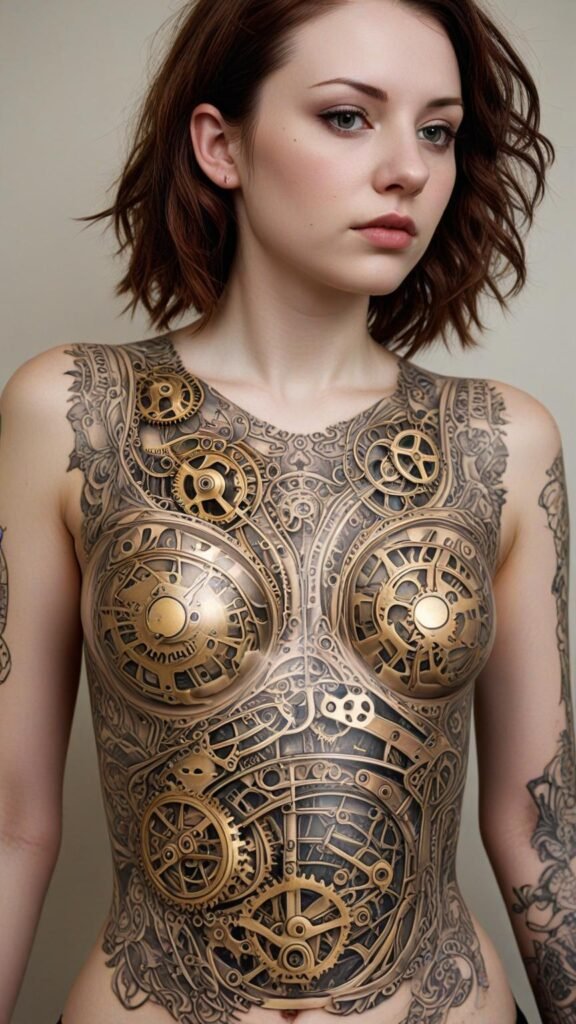
These designs work particularly well when they incorporate the intricate internal mechanisms. Gears, springs, and the distinctive star-shaped metal disc create fascinating geometric patterns. Some people choose to show the music box mid-song, with musical notes seeming to drift up from the mechanism like musical smoke.
The Swiss craftsmanship tradition behind these devices adds another layer of meaning. These tattoos can represent precision, patience, and the idea that the most beautiful things often come in small, carefully crafted packages. They’re perfect for people who appreciate both music and mechanical ingenuity.
13. Conductor’s Baton and Orchestra Imagery
The conductor stands at the intersection of individual talent and collective harmony, wielding nothing more than a slender baton to shape entire orchestras. Conductor tattoos celebrate leadership, collaboration, and the magical moment when many voices become one.
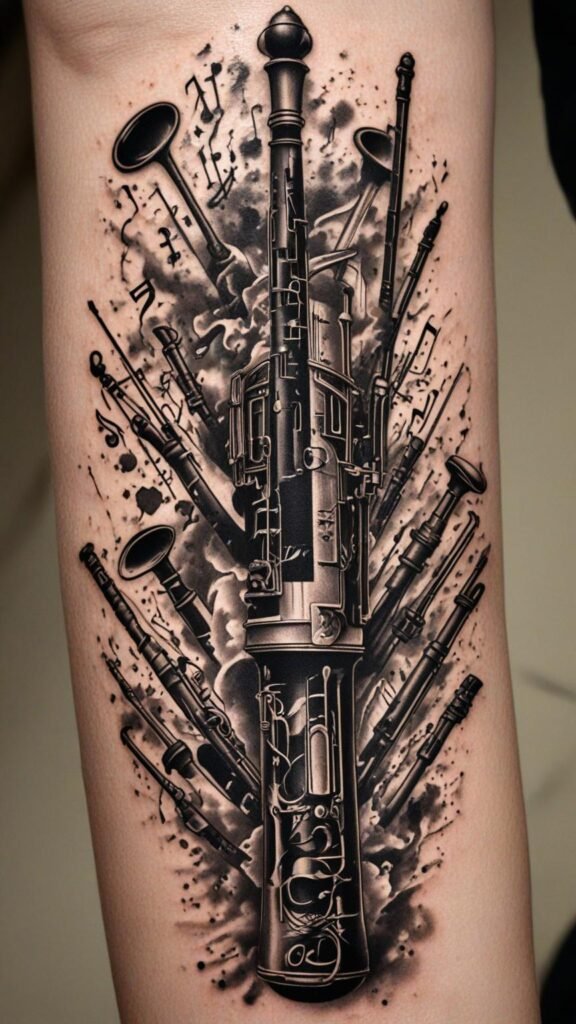
A conductor’s baton can be surprisingly elegant in tattoo form—its simple lines and graceful proportions work beautifully as minimalist designs. Some people choose to surround the baton with swirling musical notation that seems to dance in response to the conductor’s movements. Others prefer the baton alone, perhaps crossing another meaningful symbol or integrated into a larger musical composition.
Orchestra imagery offers rich possibilities for larger tattoo pieces. Silhouettes of string sections, the curved lines of brass instruments, or the geometric patterns created by music stands can form complex, layered designs. These tattoos often work best when they capture the energy and movement of live performance rather than static imagery.
14. Vinyl Record Labels and Center Holes
While vinyl records themselves are popular tattoo subjects, focusing specifically on the record labels and center holes creates more intimate, detail-oriented designs. These small circles contained entire worlds of information—record company logos, catalog numbers, song titles, and artist credits that told stories about musical history and discovery.
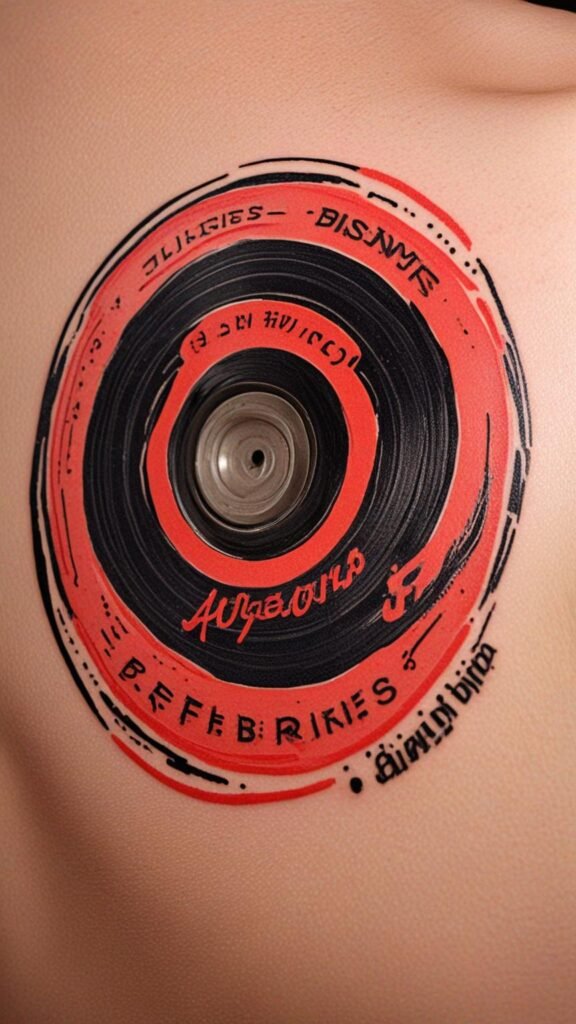
Classic labels like Blue Note’s distinctive typography, Motown’s bold circular design, or punk labels’ deliberately rough aesthetics each carry their own cultural weight. Getting your favorite label tattooed shows deep appreciation for not just individual songs, but entire musical movements and the visionaries who brought them to the world.
The center hole itself, that simple circle that seems almost insignificant, actually represents the entire mechanical process that makes recorded music possible. Some people choose to have light seeming to emanate from this central point, suggesting that all music radiates from this simple technological innovation.
15. Music Therapy and Healing Symbols
Music’s therapeutic power deserves recognition in tattoo form. These designs combine traditional musical elements with symbols of healing, growth, and emotional transformation. They’re particularly meaningful for people who’ve used music to overcome challenges or who work in music therapy professions.
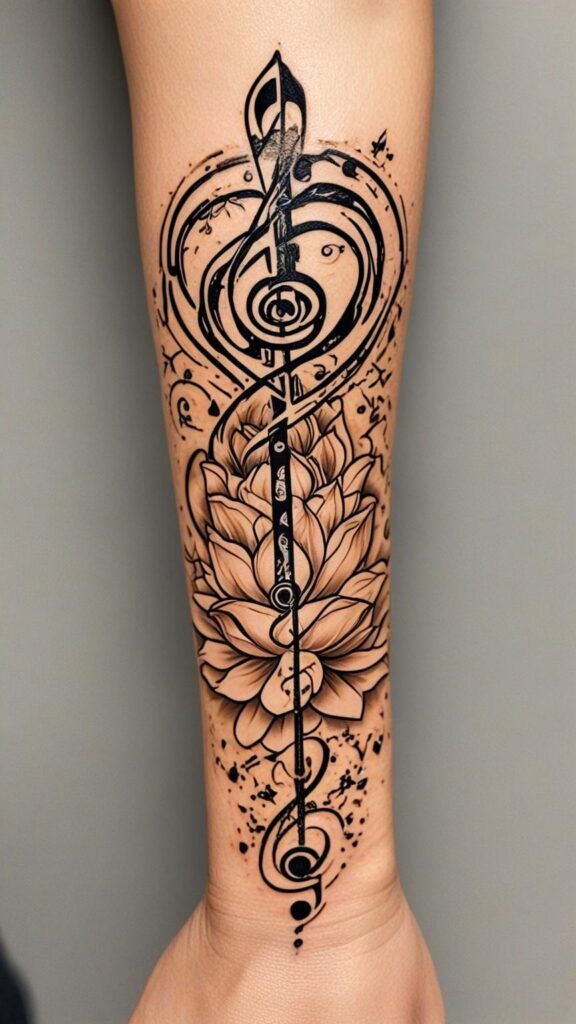
Healing symbols from various cultures—Celtic knots, Buddhist wheels, Native American dreamcatchers—can be integrated with musical notation to create deeply spiritual designs. Musical notes might form the pattern of a DNA double helix, suggesting that music is literally part of our genetic makeup.
Some people choose to represent specific songs or pieces that helped them through difficult times. A musical phrase that provided comfort during grief, motivation during recovery, or hope during depression becomes a permanent reminder of music’s healing power. These tattoos often incorporate elements like growing vines, healing hands, or light breaking through darkness.
16. Cassette Tapes and Mixtape Culture
Before streaming and even before CDs, cassette tapes were the medium through which we shared musical love. Mixtapes weren’t just playlists—they were carefully curated emotional journeys, complete with handwritten track listings and personalized artwork.
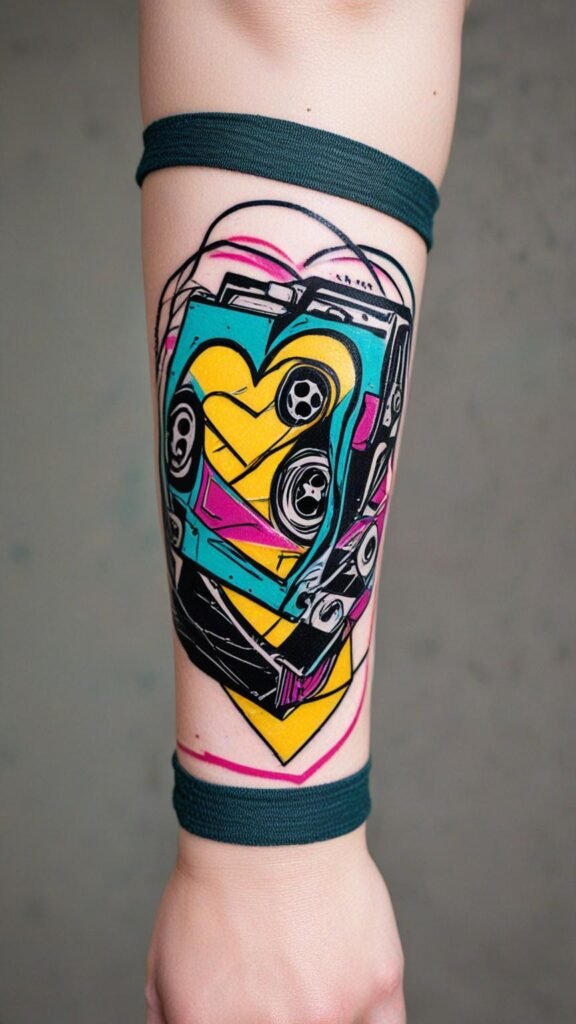
Cassette tattoos celebrate this intimate, analog way of sharing music. The rectangular shape works well for various body placements, and the internal mechanics—those tiny gears and the magnetic tape itself—create interesting geometric patterns. Some people choose to show the tape partially unspooled, with musical notes replacing the magnetic tape.
The handwritten elements of mixtape culture provide opportunities for incorporating personal typography. Song titles, inside jokes, or messages to loved ones can be integrated into the cassette design. These tattoos often represent specific relationships or moments when someone made you a tape that changed your musical world.
17. Music Production Waveforms and Studio Patterns
Modern music production creates its own visual language through digital audio workstations, spectrum analyzers, and waveform displays. These technical representations of sound can be transformed into surprisingly beautiful tattoo designs that celebrate the craft of music making.
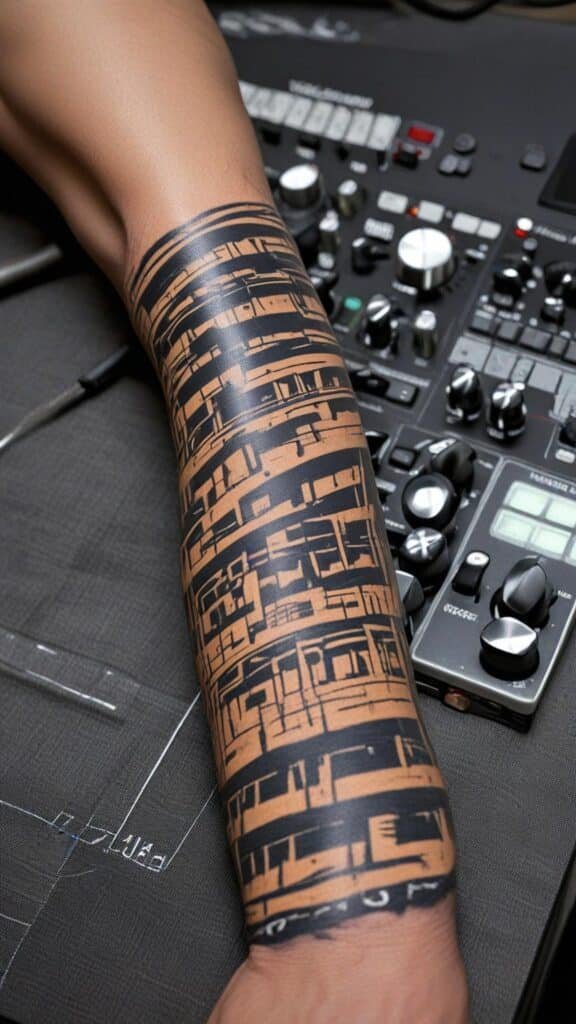
Waveform patterns from your own musical creations become deeply personal tattoo subjects. Whether you’re a bedroom producer or professional engineer, seeing your creative work translated into visual form creates a unique connection between your art and your body. The organic curves and sharp peaks of audio waveforms create naturally flowing designs.
Spectrum analyzer displays, with their colorful frequency representations, offer opportunities for vibrant, technically-minded tattoos. Some people choose to show the exact frequency response of their voice or instrument, creating a visual signature that’s as unique as a fingerprint.
18. Cultural Music Symbols from Around the World
Music transcends borders, and tattoos celebrating global musical traditions create opportunities for beautiful, culturally-rich designs. These tattoos require respectful research and understanding of the traditions they represent, but they can create stunning tributes to music’s universal language.
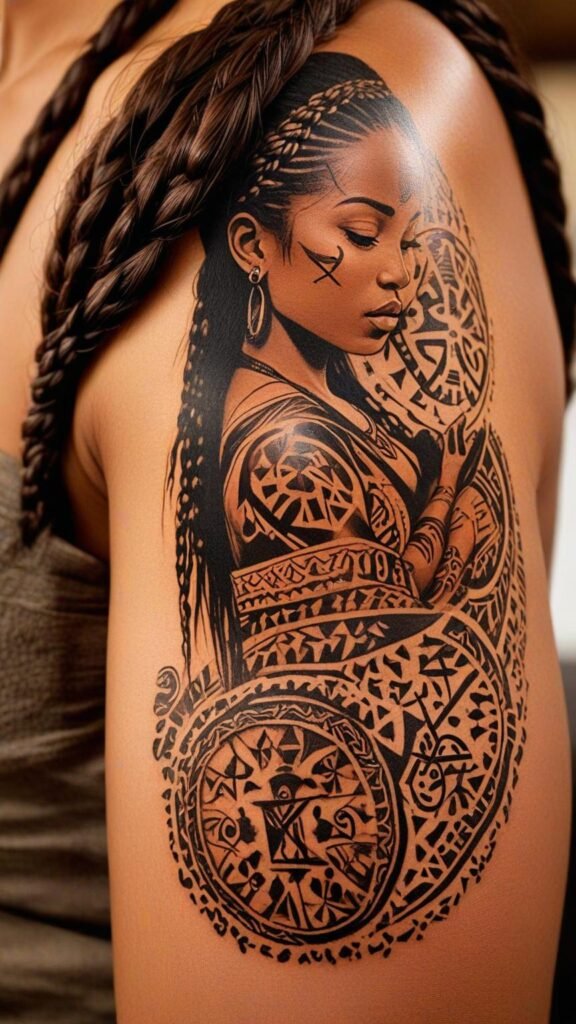
Indian classical music offers rich symbolic possibilities—the curved lines of a sitar, the intricate patterns of tabla drums, or the spiritual significance of the om symbol combined with ragas. African musical traditions provide rhythmic patterns that translate beautifully to tattoo designs, from djembe drum surfaces to the geometric patterns found in traditional instruments.
Celtic musical traditions offer knotwork patterns that can incorporate musical elements, while Asian musical traditions provide elegant calligraphy and symbolic representations. The key is approaching these designs with respect and understanding, perhaps working with artists from these traditions to ensure authentic representation.
19. Musician Silhouettes in Performance
Capturing the energy and passion of live performance, these tattoos focus on the human element of music creation. Rather than just instruments or technical elements, they celebrate the physical act of making music and the emotional connection between performer and audience.
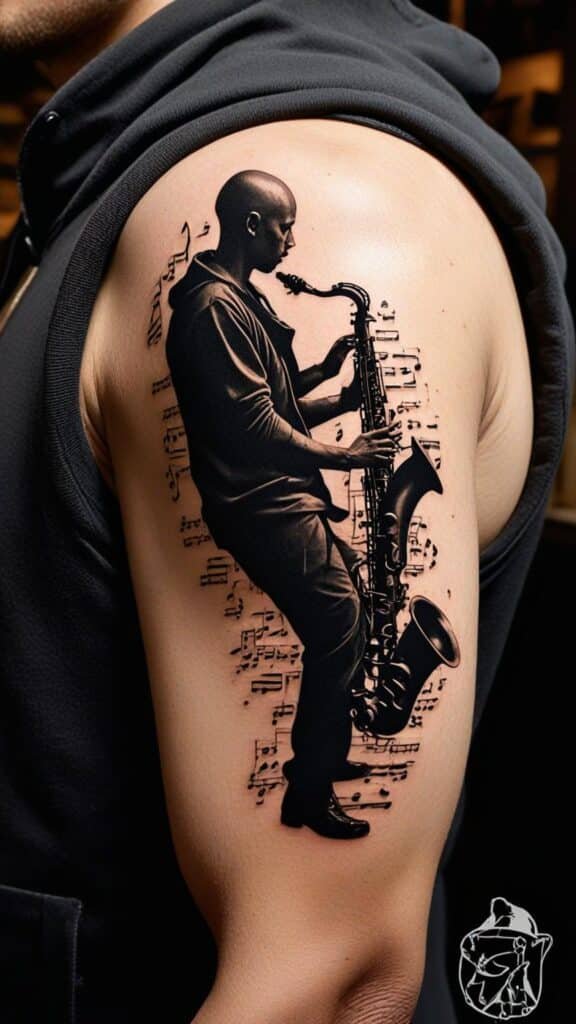
A guitarist mid-solo, head thrown back in musical ecstasy. A pianist’s hands dancing across keys with fingers blurred by motion. A drummer caught in the perfect moment of a powerful strike. These silhouettes capture the poetry of musical performance without requiring photorealistic detail.
The key to successful performance silhouettes is capturing gesture and movement rather than specific features. These tattoos should convey emotion and energy rather than documentary accuracy. They work particularly well when combined with other musical elements—perhaps notes flowing from the performer or stage lights creating dramatic shadows.
20. Music-Inspired Sacred Geometry and Mathematical Patterns
Music and mathematics have been connected since ancient Greek philosophers discovered the mathematical ratios underlying harmonic intervals. Tattoos exploring this connection create designs that are both visually striking and intellectually satisfying.
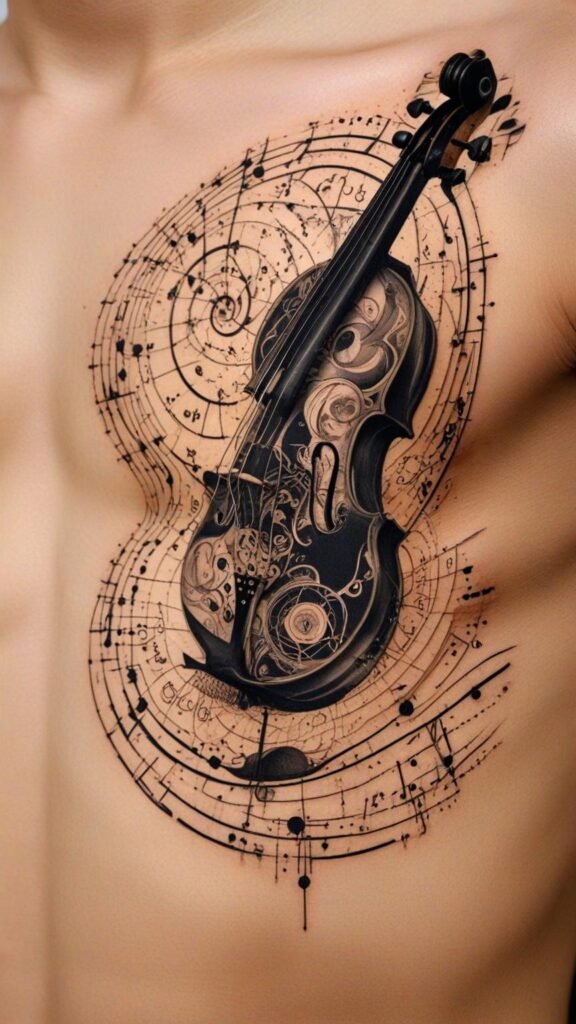
The golden ratio appears throughout musical composition and can be represented through spirals filled with musical notation. Fibonacci sequences, which appear in everything from flower petals to musical phrases, can be visualized through numbers morphing into musical notes. These designs appeal to people who see music as a fundamental principle of universal organization.
Cymatics—the study of visible sound vibrations—provides another avenue for mathematical music tattoos. The geometric patterns created when sound waves interact with physical materials can be recreated as intricate mandala-like designs. These tattoos represent the literal visualization of music’s invisible power to create order and beauty.
The most important thing is choosing a design that resonates with your personal musical journey. Work with an experienced tattoo artist who understands the importance of musical details and can help bring your vision to life. After all, just like music itself, the best tattoos are those that speak directly to the soul.

Lex memn is a passionate tattoo artist and writer with 3 years of experience in the tattoo world. Dedicated to inspiring and guiding people through creative designs and meaningful tattoo ideas, Lex memn shares their expertise with readers. Explore their work and passion for ink at TifoMags!

